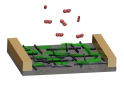News Release 04-148
Monitoring Life, One Breath at a Time
Respiratory sensor may provide new tool for emergency responders

Atomic force microscopy (AFM) image of the carbon nanotube network device coated with poly(ethyl ...
November 10, 2004
This material is available primarily for archival purposes. Telephone numbers or other contact information may be out of date; please see current contact information at media contacts.
Arlington, Va.—Researchers have created a tiny device that can monitor a victim's breathing in emergency situations by effectively shrinking an operating room machine into a small, disposable tool that can be carried to a disaster site.
NSF-supported researchers at Nanomix, Inc., in Emeryville, Calif., have created a transistor that fuses carbon nanotubes, polymers and silicon into a capnography sensor -- a human breathing monitor.
Alexander Star and his colleagues at Nanomix and the University of California, Los Angeles, describe the new sensor in the cover article of the November 15 issue of the journal Advanced Materials. Their study shows that carbon nanotube transistors fused with carbon dioxide-detecting polymers can determine carbon dioxide (CO2) concentrations in both ambient and exhaled air.
Capnography sensors detect subtle changes in the concentration of carbon dioxide gas in a person's breath, revealing respiratory diseases in children and adults, and allowing anesthesiologists to monitor a patient's breathing during surgery.
In the field, emergency responders may be able to use the new sensor to verify proper breathing tube placement, monitor the patient's respiratory patterns and assess the effect of life support measures.
While the Nanomix device is already capable of monitoring human breathing in laboratory settings, the researchers are collaborating with anesthesiologists and other specialists at the University of California, San Francisco, to design and test a field-ready medical device.
The Nanomix researchers developed their nanotube transistor as part of NSF's Small Business Innovation Research program, and they are also applying the new technology to optoelectronic memory applications.
The same electronic interactions between polymers and carbon nanotubes that sense CO2 can also yield photo-sensitive devices that record the binary "on" and "off" patterns of digital memory. The memory is written optically, but read and erased electronically.
When researchers shine light on the polymer-coated nanotube transistors, electric signals are stored as charges in the nanotubes. Because different polymers absorb light differently, engineers can tune the device to work under specific light waves. By changing the voltage in the device, one can control the read and erase functions.
These research results, which were published in the September issue of Nano Letters, differ from other memory and optical applications of nanotube transistors.
Comments from the researchers:
"We have developed nanoelectronic sensors that accurately measure carbon dioxide in human breath. This sensing technology will break new ground in the development of medical devices that take advantage of the unique qualities of nanotechnology – small size, low power and high sensitivity." -- Alexander Star, Manager, Applications Development, Nanomix, Inc.
"We are using two-layer nanodevice assembly, which allows us to control each component to change the operation of the devices. While the nanotube layer defines the density and complexity of nanodevice arrays on the chip, we can independently fine-tune the devices by using different polymers." -- Alexander Star
Comments from UCSF:
"Being able to continuously and accurately measure carbon dioxide in exhaled breath with a small, inexpensive and pre-calibrated device is a very significant development in clinical care. It will improve emergency care in the field by helping guide resuscitation efforts and also provide important feedback about adequacy of ventilation. " -- Philip E. Bickler, Department of Anesthesia and Perioperative Care, University of California, San Francisco
Comments from NSF:
"The potential impact of this device is huge. This technology could lead to a low-cost, small-size, low-power carbon dioxide sensor. The high-sensitivity device might replace bulky and expensive NDIR (non-dispersive infrared absorption) sensors." -- Winslow Sargeant, NSF Small Business Innovation Research Program officer who oversees the Nanomix award.
"This is a high-risk, high-return technology. On a larger scale, the finalized product would lower the cost of respiratory tract monitoring, becoming an essential tool for intensive care units and during anesthesia." -- Winslow Sargeant
-NSF-
-
Conceptual illustration of the carbon nanotube network device coated with poly(ethylene imine) a ...
Credit and Larger Version
For more information on this research, see: http://www.nano.com/nr-article-081704.html.
Media Contacts
Josh Chamot, NSF, (703) 292-7730, email: jchamot@nsf.gov
Program Contacts
Winslow Sargeant, NSF, (703) 292-7313, email: wsargean@nsf.gov
Principal Investigators
Alexander Star, Nanomix, Inc, (510) 428-5323, email: AStar@nano.com
Co-Investigators
Philip E. Bickler, University of California, San Francisco, (415) 476-1411, email: bicklerp@anesthesia.ucsf.edu
The U.S. National Science Foundation propels the nation forward by advancing fundamental research in all fields of science and engineering. NSF supports research and people by providing facilities, instruments and funding to support their ingenuity and sustain the U.S. as a global leader in research and innovation. With a fiscal year 2023 budget of $9.5 billion, NSF funds reach all 50 states through grants to nearly 2,000 colleges, universities and institutions. Each year, NSF receives more than 40,000 competitive proposals and makes about 11,000 new awards. Those awards include support for cooperative research with industry, Arctic and Antarctic research and operations, and U.S. participation in international scientific efforts.
Connect with us online
NSF website: nsf.gov
NSF News: nsf.gov/news
For News Media: nsf.gov/news/newsroom
Statistics: nsf.gov/statistics/
Awards database: nsf.gov/awardsearch/
Follow us on social
Twitter: twitter.com/NSF
Facebook: facebook.com/US.NSF
Instagram: instagram.com/nsfgov



